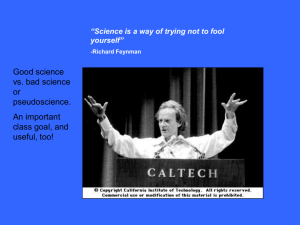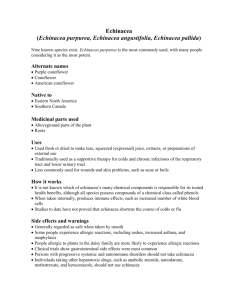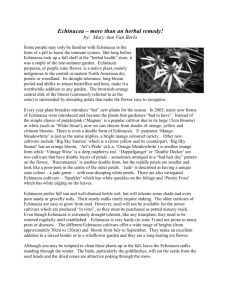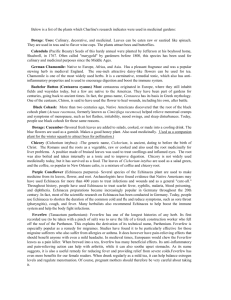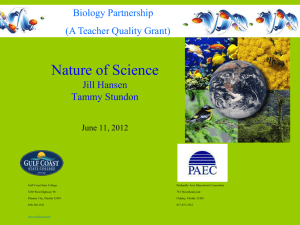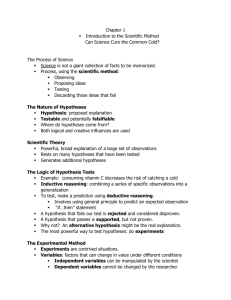Current Research Journal of Biological Sciences 4(5): 596-599, 2012 ISSN: 2041-0778
advertisement
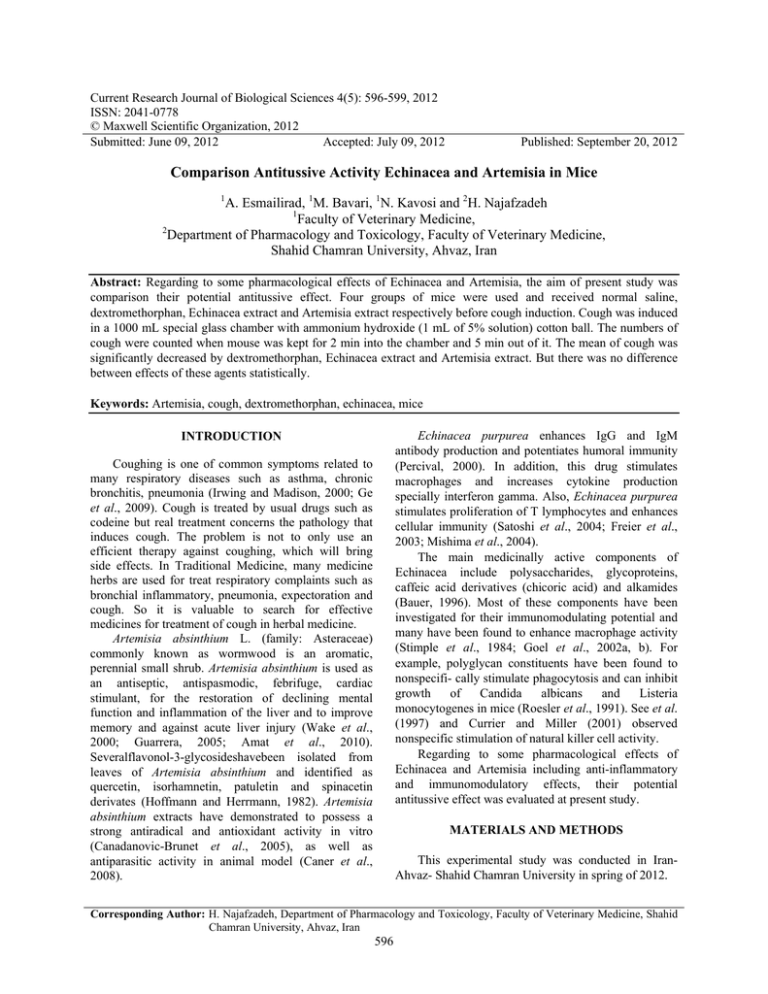
Current Research Journal of Biological Sciences 4(5): 596-599, 2012 ISSN: 2041-0778 © Maxwell Scientific Organization, 2012 Submitted: June 09, 2012 Accepted: July 09, 2012 Published: September 20, 2012 Comparison Antitussive Activity Echinacea and Artemisia in Mice 1 A. Esmailirad, 1M. Bavari, 1N. Kavosi and 2H. Najafzadeh 1 Faculty of Veterinary Medicine, 2 Department of Pharmacology and Toxicology, Faculty of Veterinary Medicine, Shahid Chamran University, Ahvaz, Iran Abstract: Regarding to some pharmacological effects of Echinacea and Artemisia, the aim of present study was comparison their potential antitussive effect. Four groups of mice were used and received normal saline, dextromethorphan, Echinacea extract and Artemisia extract respectively before cough induction. Cough was induced in a 1000 mL special glass chamber with ammonium hydroxide (1 mL of 5% solution) cotton ball. The numbers of cough were counted when mouse was kept for 2 min into the chamber and 5 min out of it. The mean of cough was significantly decreased by dextromethorphan, Echinacea extract and Artemisia extract. But there was no difference between effects of these agents statistically. Keywords: Artemisia, cough, dextromethorphan, echinacea, mice Echinacea purpurea enhances IgG and IgM antibody production and potentiates humoral immunity (Percival, 2000). In addition, this drug stimulates macrophages and increases cytokine production specially interferon gamma. Also, Echinacea purpurea stimulates proliferation of T lymphocytes and enhances cellular immunity (Satoshi et al., 2004; Freier et al., 2003; Mishima et al., 2004). The main medicinally active components of Echinacea include polysaccharides, glycoproteins, caffeic acid derivatives (chicoric acid) and alkamides (Bauer, 1996). Most of these components have been investigated for their immunomodulating potential and many have been found to enhance macrophage activity (Stimple et al., 1984; Goel et al., 2002a, b). For example, polyglycan constituents have been found to nonspecifi- cally stimulate phagocytosis and can inhibit growth of Candida albicans and Listeria monocytogenes in mice (Roesler et al., 1991). See et al. (1997) and Currier and Miller (2001) observed nonspecific stimulation of natural killer cell activity. Regarding to some pharmacological effects of Echinacea and Artemisia including anti-inflammatory and immunomodulatory effects, their potential antitussive effect was evaluated at present study. INTRODUCTION Coughing is one of common symptoms related to many respiratory diseases such as asthma, chronic bronchitis, pneumonia (Irwing and Madison, 2000; Ge et al., 2009). Cough is treated by usual drugs such as codeine but real treatment concerns the pathology that induces cough. The problem is not to only use an efficient therapy against coughing, which will bring side effects. In Traditional Medicine, many medicine herbs are used for treat respiratory complaints such as bronchial inflammatory, pneumonia, expectoration and cough. So it is valuable to search for effective medicines for treatment of cough in herbal medicine. Artemisia absinthium L. (family: Asteraceae) commonly known as wormwood is an aromatic, perennial small shrub. Artemisia absinthium is used as an antiseptic, antispasmodic, febrifuge, cardiac stimulant, for the restoration of declining mental function and inflammation of the liver and to improve memory and against acute liver injury (Wake et al., 2000; Guarrera, 2005; Amat et al., 2010). Severalflavonol-3-glycosideshavebeen isolated from leaves of Artemisia absinthium and identified as quercetin, isorhamnetin, patuletin and spinacetin derivates (Hoffmann and Herrmann, 1982). Artemisia absinthium extracts have demonstrated to possess a strong antiradical and antioxidant activity in vitro (Canadanovic-Brunet et al., 2005), as well as antiparasitic activity in animal model (Caner et al., 2008). MATERIALS AND METHODS This experimental study was conducted in IranAhvaz- Shahid Chamran University in spring of 2012. Corresponding Author: H. Najafzadeh, Department of Pharmacology and Toxicology, Faculty of Veterinary Medicine, Shahid Chamran University, Ahvaz, Iran 596 Curr. Res. J. Biol. Sci., 4(5): 596-599, 2012 100 90 80 70 60 50 40 30 20 10 0 mean of cough was 29.16±4.11. But there was no difference between effects of these agents statistically (Fig. 1). Mean of cough * DISCUSSION 1 2 3 4 Groups Fig. 1: Mean±SEM of cough in mice (n = 6 each group) 1: Saline; 2: Dextromethorphan; 3: Artemisia extract; 4: Echinacea extract; *: Significant difference (p<0.05) Hydro-alcoholic extract of aerial parts of Echinacea purpurea was from Goldaruo Co. Isfahan, Iran. The fresh roots of Artemisia absinthium were collected from Kerman-Iran area. They were shade-dried, powdered and after extraction by maceration method in 70% methanol and water. NMRI mice of either sex were randomly divided into 4 groups of 5 mice each. Animals received normal saline, dextromethorphan 10 mg/kg, Echinacea extract 500 mg/kg and Artemisia extract 50 mg/kg, respectively before cough induction. All drugs were orally administrated by feeding tube. The mice were exposed to a 1000 mL special glass chamber with 5% ammonium hydroxide (1 mL) cotton ball after 30 min of the last administration and the cough incubation period was recorded. After 2 min, the mice were taken out from the chamber and placed in a beaker and the frequency of cough within 5 min was observed and recorded (Li et al., 2012). Cough in mice is that opening the mouth accompanying sound of coughing. The antitussive results are expressed as mean±Standard Error of Mean (SEM). Significance was evaluated using the Student’s t-test. Statistical significance between groups was determined using SPSS program (USA, version16). The minimum level of significance was p<0.05. RESULTS The mean of cough was 86±6.05 in group of mice which received saline. The mean of cough was significantly decreased by dextromethorphan and reached to 20.16±4.51 (p<0.001). Artemisia extract significantly depressed cough (p<0.001) and the mean of cough was 23.16±4.46. Echinacea extract significantly decreased coughing (p<0.001) and the The primary objective of this study was to evaluate the antitussive effect of Echinacea purpurea and Artemisia absinthium extract to provide experimental evidence for its traditional use. Their antitussive effects were measured using murine model of ammonia induced cough. These extracts significantly inhibited cough frequency of cough in mice induced by ammonia. Artemisia absinthium extracts have a strong antiradical and antioxidant activity (CanadanovicBrunet et al., 2005). Echinacea purpurea has antiinflammatory effects (Barrett, 2003). Moreover, Echinacea has anti-oxidative and free-radical scavenging activity. The antitissive effect of these extracts may be related to their active compounds including flavonoids and polysaccharides. Echinacea is used for treatment of acute upper respiratory infections including common cold and influenza (Hu and Kitts, 2000; Barrett, 2003; Steven and Kejian, 2004). In one study, Echinacea purpurea root increased levels of interloukine l and 6, tumor necrosing factor and antibody production more than extracts of Echinacea angustifolia and Echinacea pallida (Skarek et al., 1996). Bukovsky et al. (1995) reported that ethanolic extract of Echinacea purpurea increased activity of mouse peritoneal macrophage following 5 days exposure (Bukovsky et al., 1995). In one doubleblinded study in 24 men, oral administration of Echinacea purpurea extract increased Polymorphonuclear (PMN) phagocytic activity for 5 days that reached its peak levels at 5th day. Senchina et al. (2006) and studied that dried Echinacea roots retain cytokine-modulating capabilities in an in vitro human older adult model of influenza vaccination (Senchina et al., 2006). Echinacea had an enhancing effect on efficiency of influenza vaccine (Najafzadeh et al., 2011). CONCLUSION In conclusion, Artemisia extract and Echinacea extract has antitussive effect, although it is needed to evaluate their effective compound. It is suggested that their antitussive effect examined by other cough models. ACKNOWLEDGMENT The authors wish to express their gratitude to the research council of Shahid Chamran University for their financial supports. 597 Curr. Res. J. Biol. Sci., 4(5): 596-599, 2012 REFERENCES Amat, N., H. Upur and B. Blazekovi, 2010. In vivo hepatoprotective activity of the aqueous extract of Artemisia absinthium L: Against chemically and immunologically induced liver injuries in mice. J. Ethnopharmacol., 131: 478-484. Barrett, B., 2003. Medicinal properties of Echinacea. Phytomedicine, 10: 66-86. Bauer, R., 1996. Echinacea drugs, effects and active ingredients. Z. Aerztl. Fortbild, (Jena), 90: 111-115. Bukovsky, M., S. Vaverkova and D. Kostalova, 1995. Immunomodulating activity of Echinacea gloriosa L., Echinacea angustifolia DC and Rudbeckia speciosa Wenderoth ethanol-water extracts. Pol. J. Pharmacol., 4: 175-177. Canadanovic-Brunet, J.M., S.M. Djilas, G.S. Cetkovic and V.T. Tumbas, 2005. Free-radical scavenging activity of worm wood (Artemisia absinthium L.) extracts. J. Sci. Food Agric., 85: 265-272. Caner, A., M. Doskaya, A. Degirmenci, H. Can, S. Baykan, A. Uner, G. Basdemir, U. Zeybek and Y. Guruz, 2008. Comparison of the effects of artemisia vulgaris and artemisia absinthium growing in western Anatolia against trichinellosis (Trichinella spiralis) in rats. Exper. Parasitol., 119: 173-179. Currier, N.L. and S.C. Miller, 2001. Echinacea purpurea and melatonin augment natural-killer cells in leukemic mice and prolong life Span. J. Altern. Complement, Med., 7: 241-251. Freier, D.O., K. Wright, K. Klein, D. Voll, K. Dabiri, K. Cosulich and R. George, 2003. Enhancement of the humoral immune response by Echinacea purpurea in female Swiss mice. Immunopharmacol. Immunotoxicol., 25(4): 551-60. Ge, Y.B., J.Q. Liu and D.F. Su, 2009. In vivo evaluation of the anti-asthmatic, antitussive and expectorant activities of extract and fractions from elaeagnus pungens leaf. J. Ethnopharmacol., 126: 538-542. Goel, V., C. Chang, J.V. Slama, R. Barton, R. Bauer, R. Gahler and T.K. Basu, 2002a. Alkylimides of Echinacea purpurea stimulate alveolar macrophage function in normal rats. Int. Immunopharmacol., 2(3): 381-387. Goel, V., C. Chang, J.V. Slama, R. Barton, R. Bauer, R. Gahler and T.K. Basu, 2002b. Echinacea stimulates macrophage function in the lung and spleen of normal rats. J. Nutrit. Biochem., 13: 487-492. Guarrera, P.M., 2005. Traditional phytotherapy in central Italy (marche, abruzzo and latium). Fitoterapia, 76: 1-25. Hoffmann, B. and K. Herrmann, 1982. Flavonol Glycosides of mugwort (Artemisia vulagaris), tarragon (Artemisia dranunculus) and absinthe (Artemisia absinthium). Zeitschrift für Lebensmittel- Untersuchungund- Forschung A., 174: 211-215. Hu, C. and D. Kitts, 2000. Studies on the antioxidant activity of Echinacea root extract. J. Agric. Food Chemi., 48: 1466-1472. Irwing, R.S. and J.M. Madison, 2000. The diagnosis and treatment of cough, New England. J. Med., 34: 1715-1721. Li, Z.Y., H.J. Zhi, S.Y. Xue, H.F. Sun, F.S. Zhang, J.P. Jia, J. Xing, L.Z. Zhang and X.M. Qin, 2012. Metabolomic profiling of the flower bud and rachis of Tussilago farfara with antitussive and expectorant effects on mice. J. Ethnopharmacol., 140(1): 83-90. Mishima, S., K. Saito, H. Maruyama, M. Inoue, T. Yamashita, T. Ishida and G.U. Yeunhwa, 2004. Antioxidant and immuno-enhancing effects of Echinacea purpurea. Biol. Pharmacol. Bull., 27(7): 1004-1009. Najafzadeh, H., M. Ghorbanpour, M. Mayahi and H. Gavzan, 2011. Effect of Echinacea purpurea on antibody production against fowl influenza vaccine. J. Appl. Animal Res., 39(2): 139-141. Percival, S., 2000. Use of Echinacea in medicine. Biochem. Pharmac., 50: 155-8. Roesler, J., C. Stienmueller, A. Kiderlen, A. Emmendorffer, H. Wagner and M.L. LohmannMatthes, 1991. Application of purified polysaccharides from cell cultures of the plant Echinacea purpurea to mice mediates protection against systemic infections with Listeria monocytogenes and Candida albicans. Int. J. Immunopharmacol., 13: 27-37. Satoshi, M., S. Kiyoto, M. Hiroe, I. Makoto, Y. Takenori, I.S. Torao and G. Yeunhwa, 2004. Antioxidant and immuno-enhancing effects of Echinacea purpurea. Biol. Pharm. Bull., 27(7): 1004-1009. See, D.M., N. Broumand, L. Sahl and J.G. Tilles, 1997. In vitro effects of Echinacea and ginseng on natural killer and antibody-dependent cell cytotoxicity in healthy subjects and chronic fatigue syndrome or acquired immunodeficiency syndrome patients. Immunopharmacol., 35: 229-235. 598 Curr. Res. J. Biol. Sci., 4(5): 596-599, 2012 Senchina, D.S., L. Wu , G.N. Flinn, D.N. Konopka, J.A. McCoy, M.P. Widrlechner, E.S. Wurtele and M.L. Kohut, 2006. Year and a half old, dried Echinacea roots retain cytokine-modulating capabilities in an in vitro human older adult model of influenza vaccination. Planta Med., 72(13): 1207-1215. Skarek, T., Z. Tynecka, K. Glowniak and E. Lutostanska, 1996. Echinacea L.-Inducer of interferons. Herba Polonica., 42: 110-117. Steven, H.Y. and L. Kejian, 2004. Echinacea purpurea therapy for the treatment of the common cold a randomized, double-blind, placebo-controlled clinical trial. Arch. Intern. Med., 164: 1237-1241. Stimple, M., A. Proksch, H. Wagner and M.L. Lohmann-Matthes, 1984. Macrophage activation and induction of macrophage cytoxicity by purified polysaccharide fractions from the plant Echinacea purpurea. Infect Immun., 46: 845-849. Wake, G., A. Pickering, R. Lewis, R. Wilkins and E. Perry, 2000. CNS acetylcholine receptor activity in European medicinal plants traditionally used to improve failing memory. J. Ethnopharmacol., 69: 105-114. 599
